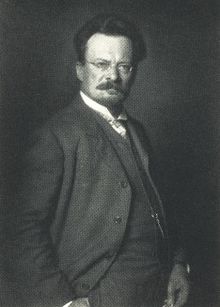Adolf Miethe
Adolf Miethe (nacido el 25 de abril de 1862 en Potsdam, murió el 5 de mayo de 1927 en Berlín) fue un científico alemán, diseñador de lentes, fotoquímico, fotógrafo, autor y educador. Co-inventó el primer flash fotográfico práctico y también hizo contribuciones muy importantes en el progreso de fotografía de color.[1]
| Adolf Miethe | ||
|---|---|---|
 Adolf Miethe en 1905 | ||
| Información personal | ||
| Nombre de nacimiento | Adolf Christian Heinrich Emil Miethe | |
| Nacimiento |
25 de abril de 1862 Potsdam (Reino de Prusia) | |
| Fallecimiento |
5 de mayo de 1927 (65 años) Berlín (República de Weimar) | |
| Religión | Luteranismo | |
| Familia | ||
| Padres |
Albert Miethe Karoline Miethe | |
| Hijos | 2 | |
| Educación | ||
| Educación | Dr. phil. y catedrático | |
| Educado en |
| |
| Información profesional | ||
| Ocupación | Fotógrafo, photochemist, profesor universitario (1899-1927), físico y optician | |
| Área | Fotografía en color, astrofotografía, espectroscopia y fotoquímica | |
| Años activo | 1890-1910 | |
| Cargos ocupados |
| |
| Empleador |
| |
| Estudiantes | Serguéi Prokudin-Gorski | |
| Distinciones |
| |
Biografía editar
Adolf Miethe creció dentro de una familia de clase media. Su padre era un fabricante de chocolate y regidor de la ciudad de Potsdam. Después de estudiar física, química y astronomía en Berlín, fue a Gotinga, donde en 1889 recibió su doctorado por una tesis sobre actinometría en fotografía astronómica en exposiciones de estrellas.[2]
Obra editar
- Tono Actinometrie astronomical photographic stellar recordings, Göttingen 1889 (dissertation)
- Pocket Calendar for amateur photographers, 1890-1895
- A photographic optical system without mathematical developments, Berlín 1893
- Broad Photographie, Halle / Saale 1893
- Textbook of practical Photographie, Halle / Saale 1896 (4 editions)
- Template leaves for photographers, Halle / Saale 1897-1903
- Three color photograph from nature, 1904 (2 editions) ( Three Colours Photography Archivado el 18 de abril de 2017 en Wayback Machine. )
- The historical development of color photography, Berlín 1905
- Knots Upper Egypt, Berlín 1909
- Photographs of the balloon from, Halle / Saale 1909 (2nd edition as the photograph from the air, Halle / Saale 1916)
- The chemical action of light, in: The Man and the Earth, Quiere 7, pp 320-384, Berlín 1911
- With Zeppelin tono Spitsbergen, Berlín and Leipzig 1911
- Natural science chats. 25 essays from the period of a quarter century, Berlín 1914
- Artistic Landscape Photography, Halle / Saale 1919
- The ABC of the light generator, Halle / Saale 1920
- The arte in the twentieth century, 6 volumes, 1911-1921 Braunschweig:
- Volume 1: The extraction of raw materiales, in 1911
- Volume 2: The processing of raw materiales, in 1912
- Volume 3: Recovery of the technical power needs and electrical energy in 1912
- Volume 4: The Transportation, the bulk manufacturing, 1912
- Volume 5: Civil Engineering, Coastal firing, aerial reconnaissance, 1920
- Volume 6: The arte in the Great War, 1921
- The self-production of a reflecting telescope (Basteln- and Build-library), Stuttgart 1920 (3 editions)
- The lady with the camera, Berlín 1925
- The Land of the Pharaohs. Egypt from Cairo tono Asuán, Bonn and Leipzig 1925
- Spitzbergen, the Alpes in the Arctic Sea. Summer trips uno. Hiking, Berlín 1925
Primeras fotografías de color editar
Fotografías de color hechas por Miethe en 1902, reproducidas fotomecánicamente en Photographische Rundschau en 1903[3]
Con una cámara diseñada por Miethe, Serguéi Prokudin-Gorski tomó una gran serie de fotografías en color del imperio ruso.[4]
Véase también editar
Referencias editar
- ↑ «The Three-Color Photography by Adolf Miethe».
- ↑ The chronology at Prokudin-Gorsky.org Archivado el 13 de mayo de 2014 en Wayback Machine. (accessed 26 September 2012) reports six weeks of study with Miethe in 1902.
- ↑ Professor Dr. Miethe's Dreifarben-Camera ("three-color camera").
- ↑ En 1902, durante 6 semanas, Prokudin-Gorski estudió con Miethe. Archivado el 13 de mayo de 2014 en Wayback Machine. (en inglés)
Bibliografía editar
- Bruno Seegert: Display of the death of Adolf Miethe. In: Astron. Msg. 230, 1927, pp 205-208. (Online )
- Michael Engel: Miethe, Adolf. In: New German Biography (NDB). Volume 17, Duncker & Humblot, Berlín 1994, ISBN 3-428-00198-2 , pp 483-485 ( digitized ).
- Adolf Miethe (1862-1927). Life memories. Edited by Helmut Seibt. Frankfurt a. M. 2012 (Acta Historica Astronomiae, 46)
- Robert Schwankner : Late alchemy, scene of Berlin 1924-26, in:. Culture and Technology in 1980, No. 3, pages 22 te seq, download donde issue archive of culture and technology of the German Museum, borne 1980
- (Ed.): Adolf Miethe (1862-1927), in TÚ Berlin: The Shoulders donde Which We stood - Pioneer of Science, Springer, Berlín 2004, page 106-108 (Jubiläumsschrift TÚ Berlin, bilingual).
Enlaces externos editar
- Wikimedia Commons alberga una categoría multimedia sobre Adolf Miethe.
- Información general
- Tres diferentes tipos de pólvora flash